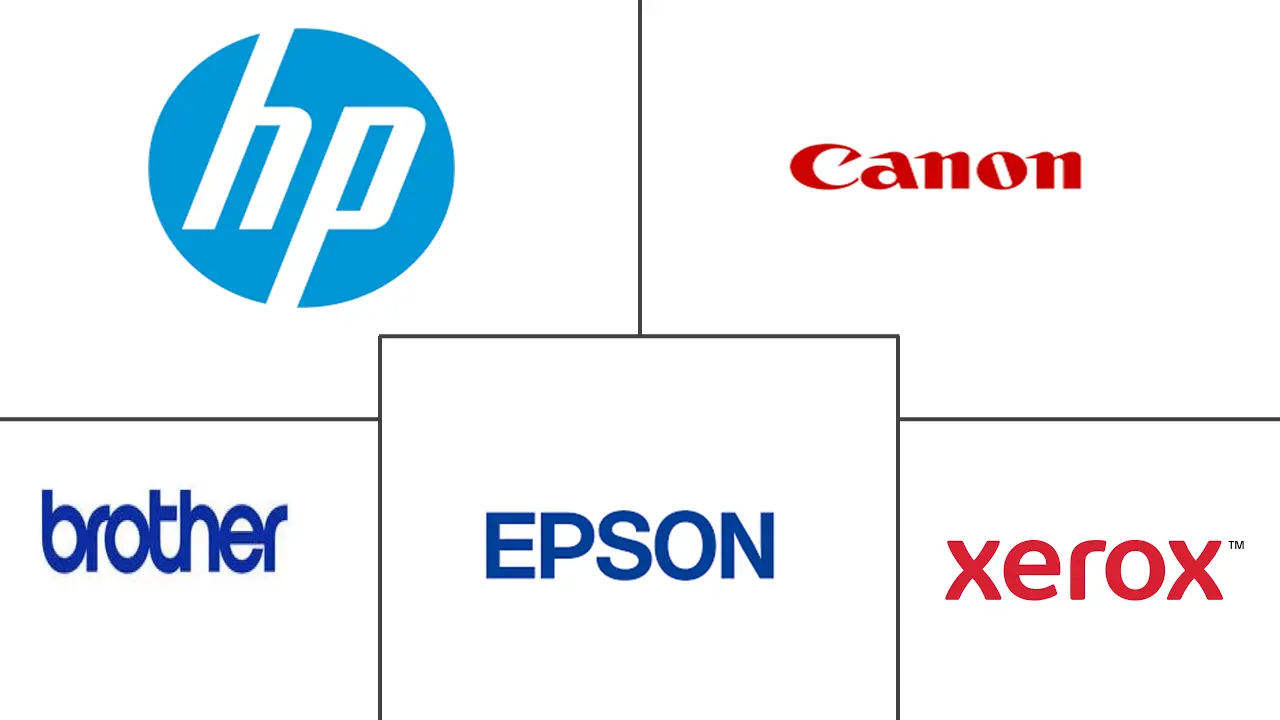Printer Market Size and Share
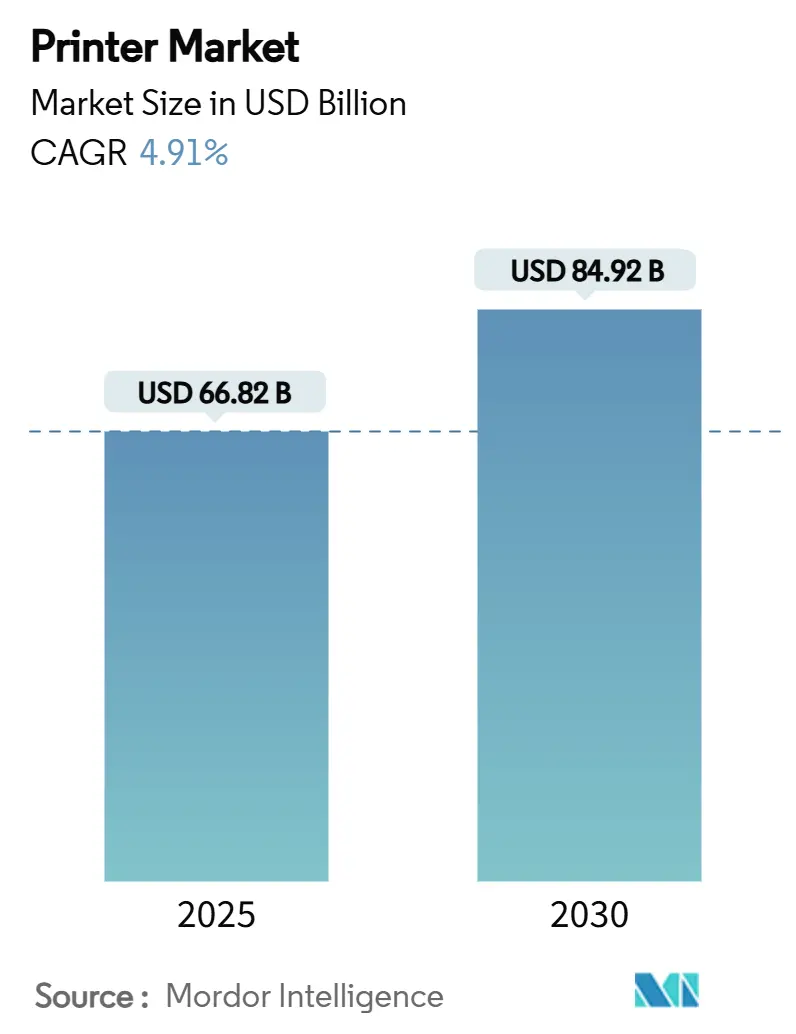
Printer Market Analysis by Mordor Intelligence
The Printer Market size is estimated at USD 66.82 billion in 2025, and is expected to reach USD 84.92 billion by 2030, at a CAGR of 4.91% during the forecast period (2025-2030).
Growth endures as traditional office printing contracts but new demand emerges from e-commerce logistics, packaging premiumization, and sustainability-driven upgrades. Multi-functional devices that consolidate print, scan, copy, and fax functions now dominate procurement decisions in hybrid offices. Ink-tank economics, thermal labeling for last-mile delivery, and color output for brand marketing keep hardware refresh cycles active even as printed office pages fall 20% from pre-pandemic levels. Manufacturers diversify into industrial and healthcare niches, buffering the printer market against digital substitution. Asia-Pacific leads revenue expansion, supported by manufacturing digitization, traceability rules, and expanding small business ecosystems.
Key Report Takeaways
- By printer type, multi-functional models held 60.7% of the printer market share in 2024; large-format units posted the fastest 5.4% CAGR through 2030.
- By technology, inkjet accounted for 48.6% of the printer market size in 2024, while thermal technology registers the highest 5.3% CAGR to 2030.
- By connectivity, wired interfaces retained 54.8% share of the printer market size in 2024; wireless options grow at 5.8% CAGR on rising IoT integration.
- By output, color devices captured 59.2% of the printer market size in 2024 and expanded 4.1% annually to 2030.
- By end-user, commercial sites contributed 52.7% revenue in 2024; healthcare and logistics adoption led with a 5.7% CAGR.
- By region, Asia-Pacific commanded 41.6% revenue in 2024 and is set to post a 6.1% CAGR through 2030.
Global Printer Market Trends and Insights
Drivers Impact Analysis
| Driver | (~) % Impact on CAGR Forecast | Geographic Relevance | Impact Timeline |
|---|---|---|---|
| Surge in e-commerce parcel volumes boosting industrial thermal label printer demand | +0.8% | Asia-Pacific core, spill-over to North America | Medium term (2–4 years) |
| Rapid adoption of ink-tank/EcoTank models lowering total cost of ownership | +0.7% | Global, strongest in Asia-Pacific and Latin America | Long term (≥ 4 years) |
| Secure hard-copy archiving of critical documents | +0.5% | Global, notably North America and Europe | Short term (≤ 2 years) |
| Packaging premiumization driving UV-curable inkjet printers | +0.6% | North America and Europe, expanding to Asia-Pacific | Medium term (2–4 years) |
| Sustainability pledges accelerating transition to LED printers | +0.4% | Europe core, expanding globally | Long term (≥ 4 years) |
| Wireless connectivity adoption enabling distributed workflows | +0.3% | Global | Short term (≤ 2 years) |
| Source: Mordor Intelligence | |||
Surge in e-commerce parcel volumes boosting industrial thermal label printer demand in Asia-Pacific
Thermal printers now underpin parcel routing across mega-fulfilment hubs in China, India, and the ASEAN bloc. The equipment’s ribbon-less architecture withstands humidity and dust while supporting millions of scannable labels per shift. Mandates for pharmaceutical and food traceability intensify demand for durable codes that survive bulk transport and cold-chain handling. Logistics operators select high-speed 6-inch models to streamline pick-pack-ship, and regional manufacturing supremacy compounds volume requirements. These fundamentals give thermal technology the strongest pull on the Asia-Pacific printer market growth, apec.org.
Rapid adoption of ink-tank/EcoTank models lowering total cost of ownership in emerging economies
Epson’s shipment of 100 million EcoTank devices confirms latent appetite for cartridge-free printing, particularly among budget-focused micro-businesses.[1]Epson, “Epson High-Capacity Ink Tank Inkjet Printers Surpass 100 Million Units,” corporate.epson Refillable reservoirs slash per-page costs by up to 90% and reduce landfill waste by minimizing single-use plastics. Savings allow family stores, tuition centers, and start-ups to expand outreach materials without steep running expenses. Lower CO₂ emissions strengthen compliance with green-procurement policies rolled out by several Latin American ministries. Together, these factors secure a multi-year boost to the printer market across high-population economies.
Secure hard-copy archiving of critical documents
Hospitals, banks, and ministries uphold physical file rooms as cyber-risk safeguards. Regulations in the United States, Germany, and Japan still require tamper-evident paper copies for audit trails, disaster recovery, and classified material. Vendors respond with embedded watermarking, encrypted job release, and self-erasing solid-state drives. Premium security functions command higher average selling prices, supporting revenue even as page counts taper. This compliance-driven niche preserves value for the printer market among risk-averse enterprises.
Packaging premiumization driving UV-curable inkjet printers for short-run labels
Consumer brands chase shelf appeal with textured, high-definition labels executed in batches of a few hundred meters. HP Indigo V12 reaches 120 linear m/min while delivering 1,600 dpi graphics, replacing multiple flexographic lines and shrinking carbon footprints.[2]HP Inc., “HP Indigo V12 Digital Press,” hp.com The capability to apply spot varnish and white ink in a single pass unlocks differentiated packaging for craft beverages, cosmetics, and nutraceuticals. Short-run agility also benefits e-commerce sellers who tailor seasonal promos, sustaining high-margin hardware demand inside the wider printer market.
Restraints Impact Analysis
| Restraint | (~) % Impact on CAGR Forecast | Geographic Relevance | Impact Timeline |
|---|---|---|---|
| Corporate cloud migration shrinking transactional print volumes | −1.2% | Global, strongest in North America and Europe | Long term (≥ 4 years) |
| Rising raw-material costs inflating consumable prices | −0.8% | Global, particularly affecting emerging markets | Medium term (2–4 years) |
| RoHS3 compliance costs limiting low-cost laser launches | −0.3% | Europe core, minimal global impact | Short term (≤ 2 years) |
| Digital signature adoption curbing check and form printing | −0.4% | North America & Europe, expanding globally | Medium term (2–4 years) |
| Source: Mordor Intelligence | |||
Corporate cloud migration shrinking transactional print volumes
Enterprise pivot to digital signatures, e-billing, and online forms pushes paper out of everyday workflows. HP confirmed a 20% page decline versus pre-COVID peaks. The shift is structural, supported by CFO mandates for paperless savings and ESG scorecards discouraging print dependence. While specialty verticals still require hard copies, the secular headwind caps overall unit growth in mature territories. Vendors counter by bundling workflow software and managed services, yet core office consumption continues to recede.
Rising raw-material costs inflating consumable prices
Tariffs on metals, plastics, and semiconductors, combined with volatile petrochemical feedstocks, have lifted toner and ink input costs. A 25% duty on several components sourced from Mexico, Canada, and China forced price adjustments across print consumables. Small and medium businesses delay equipment refreshes, stretching current fleets and dampening replacement cycles. Manufacturers explore bio-based toners and local sourcing to cushion shocks, yet pass-through pricing still narrows demand in price-sensitive regions, moderating printer market expansion.
Segment Analysis
By Printer Type: Multi-functional Devices Reinforce Fleet Consolidation
Multi-functional printers held 60.7% of 2024 revenue, anchoring the printer market where hybrid workers need flexible, compact hardware. Vendors integrate auto-double-siding, voice-activated commands, and cloud connectors so units pivot seamlessly between home and office desks. Stand-alone laser engines persist in banks and government bureaus that lock down functions for security, but volumes decline as enterprises prioritize consolidation.
Large-format systems chart the fastest 4.4% CAGR, propelled by on-demand packaging proofs, wide-banner advertising, and architectural visualization workflows. The segment benefits from print-for-pay shops shifting to digital rolls that minimize substrate waste. Industrial presses serving corrugated and flexible packaging claim premium pricing as brand owners shorten product cycles. These dynamics keep the printer market resilient even while general office volumes soften.
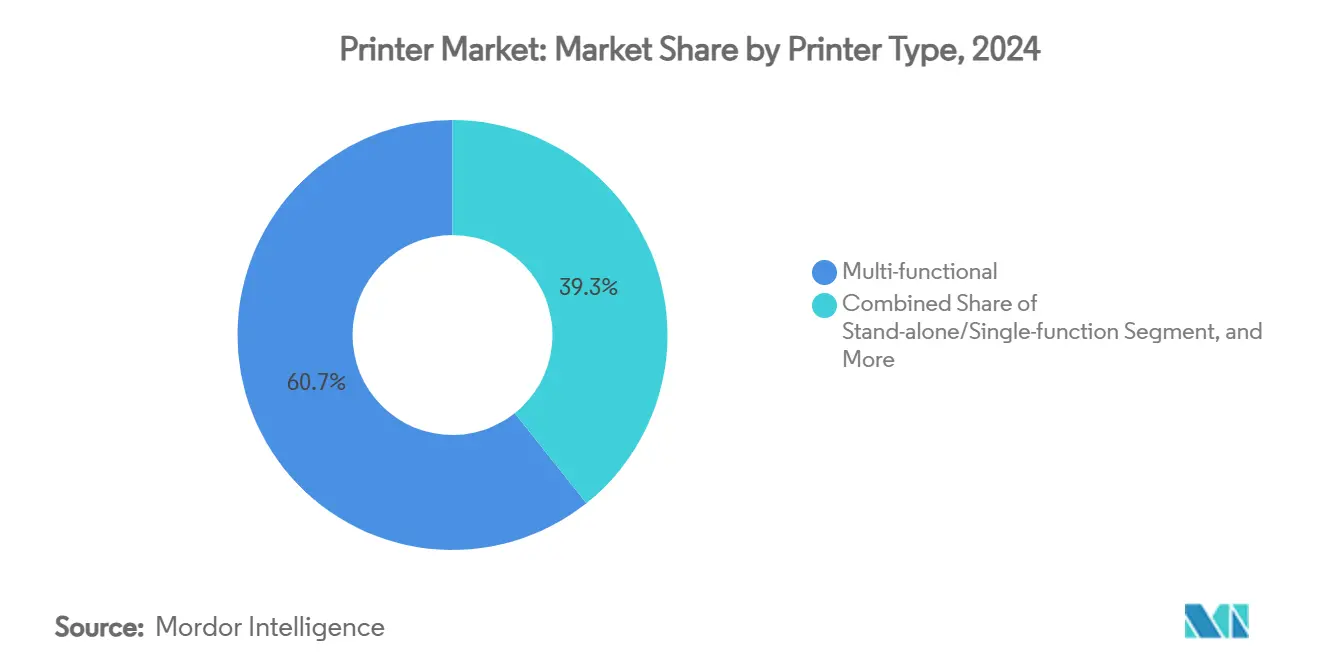
Note: Segment shares of all individual segments available upon report purchase
By Technology Type: Inkjet Leads, Thermal Accelerates
Inkjet technology captured 48.6% of 2024 revenue and anchors the printer market via home, office, and light production segments. Breakthrough PrecisionCore and piezo heads raise native speeds and widen media latitude, helping inkjet displace entry laser units in school districts and SOHOs. The printer market size for inkjet installations in production label lines is projected to grow at an overall 4.55% CAGR as the cost per image falls.
Thermal engines, though smaller by value, outpace peers at 4.3% CAGR, lifted by parcel labeling, specimen tracking, and wristband printing. Energy-efficient LED models gain mindshare in Europe, where eco procurement frameworks reward lower power draw. Conversely, laser shipments face a sunset schedule at Epson, which will exit the category by 2026 to prioritize climate goals.
By Connectivity: Wireless Uptake Supports Distributed Offices
Wired interfaces remain essential for data-sensitive networks and own 54.8% of 2024 sales. Finance, defense, and healthcare facilities keep Ethernet lines to ensure deterministic performance and compliance. Yet the wireless cohort grows 5.3% annually as Wi-Fi 6 routers proliferate and zero-trust frameworks mature.
Smartphone-initiated print, NFC tap-to-release, and cloud-queued jobs allow staff to operate anywhere, sustaining demand for firmware that over-the-air patches vulnerabilities. AI-assisted setup unveiled by HP improves out-of-box deployment and noise optimization, encouraging SMB migration. Combined, these forces pivot the printer market toward flexible architectures that align with modern IT policies.

By Output Type: Color Retains Marketing Muscle
Color lines delivered 59.2% of 2024 sales and maintain a 5.1% growth slope as consumer-facing brands refresh signage, menus, and shelf talkers. Retailers harness vivid point-of-sale graphics to lift basket value, while digital print’s variable data lets loyalty campaigns target micro-segments. Resin, latex, and UV inks broaden substrate options, extending color adoption into flooring, décor, and rigid plastics.
Monochrome office printers still dominate bank statements, legal briefs, and judicial filings. Higher-yield toner bottles and duplex defaults curb paper and cartridge costs, locking in relevance. Nonetheless, price compression narrows gaps; when a four-color page costs cents, not dimes, enterprises blend color into everyday communication, injecting incremental growth into the broader printer market.
By End-user Application: Healthcare and Logistics Outperform
Commercial venues, from creative agencies to convenience stores, produced 52.7% of 2024 revenue, backing everyday office tasks and transaction receipts. Meanwhile, healthcare and logistics add the fastest 6.7% CAGR as traceability rules demand barcoded wristbands, specimen labels, and shipping tickets. Hospitals procure disinfectant-resistant casings and antimicrobial plastics, lifting average selling prices.
Residential demand steadies on homework prints and craft projects, though tablet adoption trims page counts. Education orders sync with academic cycles, relying on duty cycles that survive exam season bursts. Government agencies sustain bid opportunities through voter registration drives and passport printing that require tamper-proof inks. Across these settings, specialist needs carve pockets of resilience within the printer market.
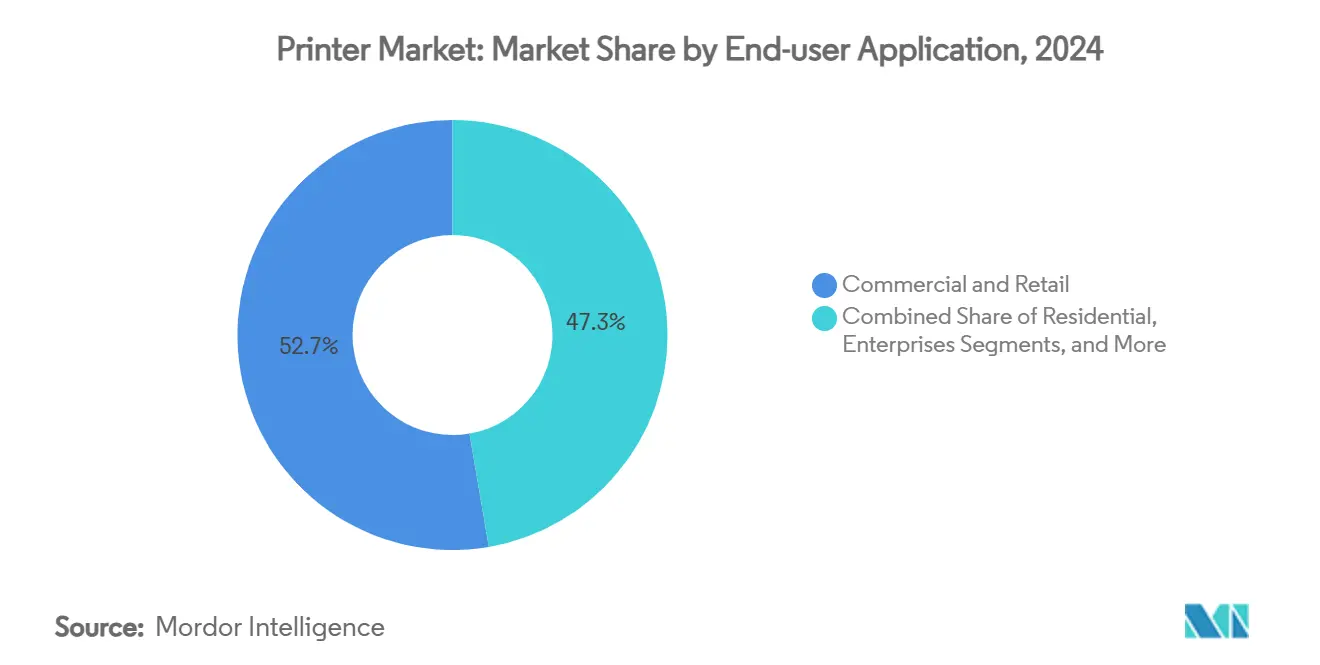
Note: Segment shares of all individual segments available upon report purchase
Geography Analysis
Asia-Pacific commands 41.6% of 2024 revenue and accelerates at a 5.1% CAGR, driven by factory automation in China and India, plus burgeoning e-commerce. Provincial grants for smart manufacturing subsidize digital label lines and serial-numbered packaging. National ID and healthcare card initiatives mandate secure print infrastructure, adding tailwinds to the printer market in the region.
North America’s mature fleet gradually transitions from legacy toner boxes to energy-sipping ink deposits. Security mandates such as HIPAA sustain hard-copy repositories even as cloud file-sharing rises. Packaging converters deploy digital presses in quick-turn cosmetic and nutraceutical lines, nurturing pockets of growth.
Europe faces cost headwinds from RoHS3 and energy taxes, yet circular-economy rules prompt organizations to adopt repairable chassis and recycled consumables, sustaining replacement momentum. Eastern Europe sees incremental demand tied to near-shoring factories that require in-plant labeling. Overall, geographic spread balances the printer market against macro shocks.
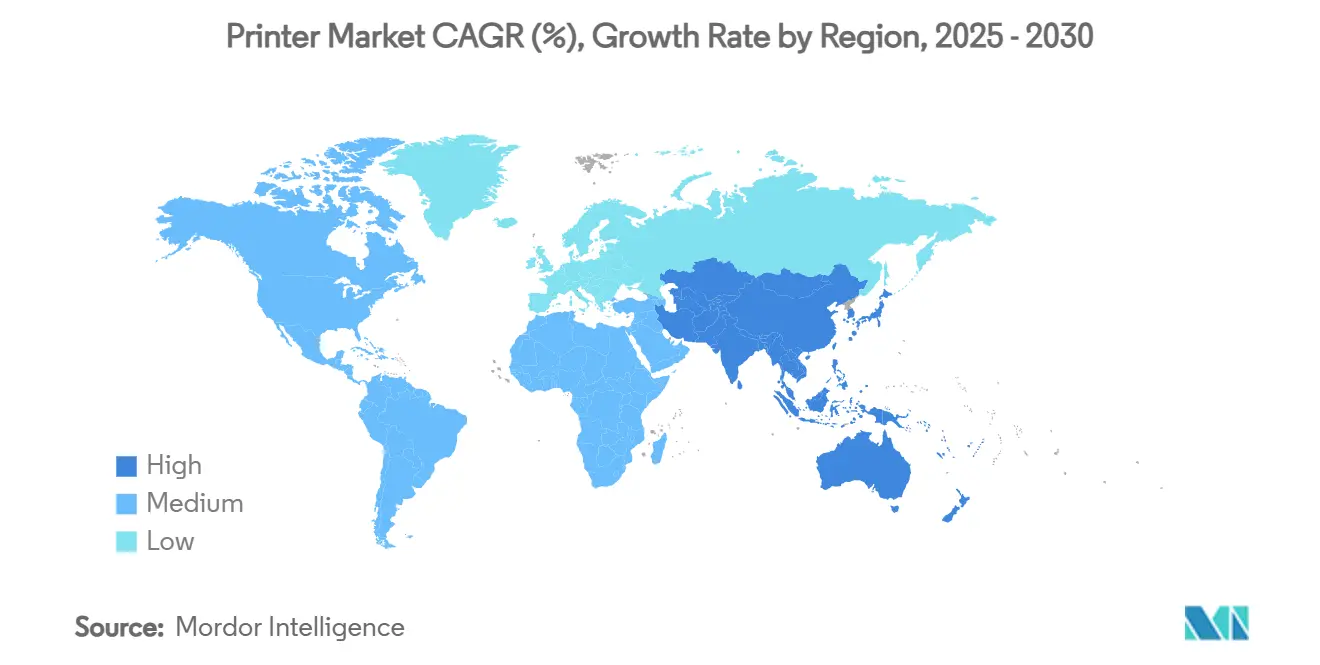
Competitive Landscape
The printer market shows moderate consolidation as diversified conglomerates snap up workflow software and specialty suppliers. Xerox announced a USD 1.5 billion takeover of Lexmark to expand A4 color reach and capture USD 200 million in synergies within two years. Epson spent USD 591 million on Fiery, securing raster image processing assets that elevate print fidelity in high-speed environments.[3]Seiko Epson Corporation, “Notice on the Acquisition of Equity Interest in Fiery,” corporate.epson
Joint ventures also reshape scale economics. Ricoh, Toshiba Tec, and OKI merged device engineering under the ETRIA alliance to share component platforms and shrink costs. Heidelberg reinforces offset heritage with digitally enabled post-press and subscription analytics, leveraging Asia-Pacific momentum for FY 2025/26 growth.
Strategic priorities concentrate on carbon reduction, AI automation, and industrial diversification. Vendors pledge recycled plastics, LED-based fusing, and bio-toners to win enterprise sustainability tenders. Cloud dashboards predict consumable depletion and schedule pre-emptive maintenance, lifting service attach rates. As a result, competition shifts from price points to lifetime value, keeping margins intact for leaders while second-tier brands struggle for visibility in the global printer market.
Printer Industry Leaders
-
HP Inc.
-
Canon Inc.
-
Seiko Epson Corporation
-
Brother Industries, Ltd.
-
Xerox Corporation
- *Disclaimer: Major Players sorted in no particular order
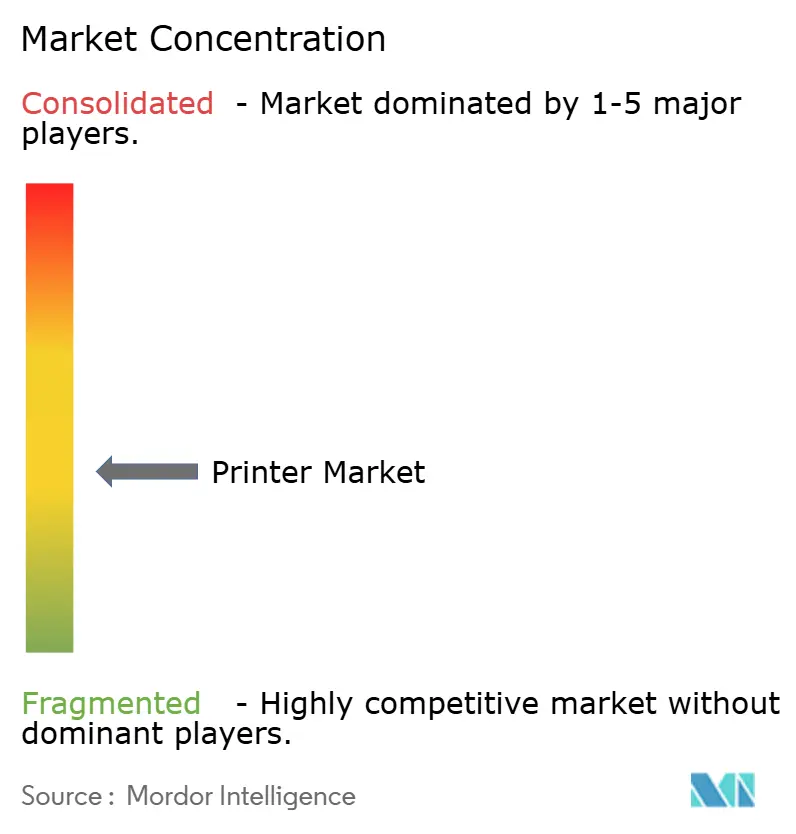
Recent Industry Developments
- June 2025: Heidelberger Druckmaschinen projected EUR 2,350 million sales for FY 2025/26 with Asia-Pacific momentum lifting the Packaging Solutions line.
- May 2025: HP posted USD 13.2 billion Q2 revenue; printing delivered USD 4.2 billion with a 19.5% operating margin.
- April 2025: Epson confirmed its exit from laser production by 2026, claiming a 2,240 GWh energy-saving potential.
- March 2025: Epson opened a new Akita printhead plant after a ¥3.5 billion outlay, tripling capacity.
Global Printer Market Report Scope
A printer is a device that uses text and graphics as input from a computer and relocates the information to paper. The study further covers the revenue generated from the sales of printers.
The printer market is segmented by printer type, technology type, printer interface, output type, end-user application, and geography. By printer type, the market is segmented into multi-functional and standalone. By technology type, the market is divided into dot matrix printer, inkjet printer, LED printer, thermal printer, and laser printer. By printer interface, the market is divided into wired and wireless. By output type, the market is segmented into color and monochrome. By end-user application, the market is divided into residential, commercial, educational institutions, enterprises, government, and other end-user applications. By geography, the market is segmented into North America, Europe, Asia-Pacific, Latin America, and the Middle East and Africa. The market sizes and forecasts are provided in terms of value (USD) for all the above segments.
| Multi-functional |
| Stand-alone/Single-function |
| Large-format |
| Industrial/Production |
| Inkjet |
| Laser |
| LED |
| Thermal (Direct and Transfer) |
| Dot-Matrix |
| Wired |
| Wireless (Wi-Fi, NFC, BT) |
| Color |
| Monochrome |
| Residential |
| Commercial and Retail |
| Educational Institutions |
| Enterprises |
| Government |
| Healthcare and Logistics |
| North America | United States | |
| Canada | ||
| Mexico | ||
| Europe | Germany | |
| United Kingdom | ||
| France | ||
| Nordics | ||
| Rest of Europe | ||
| South America | Brazil | |
| Rest of South America | ||
| Asia-Pacific | China | |
| Japan | ||
| India | ||
| Southeast Asia | ||
| Rest of Asia-Pacific | ||
| Middle East and Africa | Middle East | GCC |
| Turkey | ||
| Rest of Middle East | ||
| Africa | South Africa | |
| Rest of Africa | ||
| By Printer Type | Multi-functional | ||
| Stand-alone/Single-function | |||
| Large-format | |||
| Industrial/Production | |||
| By Technology Type | Inkjet | ||
| Laser | |||
| LED | |||
| Thermal (Direct and Transfer) | |||
| Dot-Matrix | |||
| By Connectivity/Interface | Wired | ||
| Wireless (Wi-Fi, NFC, BT) | |||
| By Output Type | Color | ||
| Monochrome | |||
| By End-user Application | Residential | ||
| Commercial and Retail | |||
| Educational Institutions | |||
| Enterprises | |||
| Government | |||
| Healthcare and Logistics | |||
| By Geography | North America | United States | |
| Canada | |||
| Mexico | |||
| Europe | Germany | ||
| United Kingdom | |||
| France | |||
| Nordics | |||
| Rest of Europe | |||
| South America | Brazil | ||
| Rest of South America | |||
| Asia-Pacific | China | ||
| Japan | |||
| India | |||
| Southeast Asia | |||
| Rest of Asia-Pacific | |||
| Middle East and Africa | Middle East | GCC | |
| Turkey | |||
| Rest of Middle East | |||
| Africa | South Africa | ||
| Rest of Africa | |||
Key Questions Answered in the Report
What is the current value of the global printer market?
The printer market stands at USD 56.82 billion in 2025 and is projected to reach USD 70.98 billion by 2030.
Which printer type holds the largest share today?
Multi-functional printers lead with 60.7% revenue share in 2024 thanks to space-saving and cost consolidation benefits.
Why is Asia-Pacific the fastest-growing region for printers?
Manufacturing digitization, booming e-commerce logistics, and government traceability mandates lift printer demand, driving a 5.1% regional CAGR through 2030.
How are sustainability goals shaping printer technology?
Vendors pivot toward LED and inkjet architectures, bio-based toners, and recyclable parts to meet corporate carbon commitments and regulatory standards.
What impact does cloud adoption have on print volumes?
Enterprise migration to digital workflows reduces transactional printing, contributing a -1.2% impact on the overall CAGR, though specialty niches keep demand stable.
Which connectivity option is gaining traction in modern offices?
Wireless printing grows at 5.8% CAGR as Wi-Fi 6 and zero-trust security make distributed printing both convenient and compliant.
Page last updated on:
